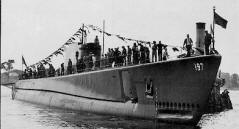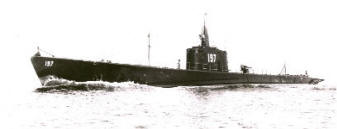
USS SEAWOLF (SS 197)
"Still at Sea, on Eternal Patrol"


Click here for
more photos
DISPLACEMENT* 2350 tons (submerged)
LENGTH *311 feet
BEAM* 27 feet
SPEED* 20 knots (surf), 8.75 knots
(submerged)
MAX OPERATING DEPTH* 250 feet
ARMAMENT* Four 21 inch torpedo tubes forward
and aft
CREW *Approx. 55
LAUNCHED *August 15, 1939
COMMISSIONED *December 1, 1939
DECOMMISSIONED* Lost at Sea, October 1944
Commanding
Officers
1939
- 1942 * LCDR F. B. Warder, USN
1943
- 1944 * LCDR R. L. Gross, USN
1944
- 1944 * LCDR R. B. Lynch, USN
1944
* LCDR A. L. Bontier, USN
The keel was laid by Portsmouth Naval Shipyard, Portsmouth, NH
on 27 September 1938 and Launched on 15 August 1939. She was sponsored by Mrs. Edward C.
Kalbfus. USS SEAWOLF (SS-197) was commissioned 1 December 1939 with LCDR
Frederick B. Warder in command.
During her 14 wartime patrols, USS SEAWOLF sank 27
and damaged 13 enemy ships for a total ships sunk tonnage of 108,600 and 69,600 for ships
damaged. On the first day of the war she started patrolling off northern Luzon and
returned with no damage to her credit. On her 2nd patrol through the passage
from Manila to Port Darwin she did not encounter any enemy ships. On her 3rd
patrol in January 1942, SEAWOLF transported a cargo of .50 caliber anti-aircraft
ammunition to Corregidor and passengers to Surabaya.
However, on her 4th patrol in the Lompoc
Straits,
SEAWOLF sank an enemy transport and damaged three light cruisers, two transports and a
freighter. For this she received the Navy Unit Commendation. On her 5th patrol,
she sank a freighter in the Philippines area, and on her 6th patrol she sank a
tanker and freighter-transport and damaged another tanker in the Makassar Strait.
On her 7th patrol, SEAWOLF made the
passage from Fremantle to Pearl Harbor and patrolled at Davao Gulf, Palau, and YAP
enroute. On 3 November 1942 she sank the Japanese freighter-transport Sagami Maru
40
miles inside the mouth of Davao Gulf. On this same patrol, she also sank two
freighter-transports and damaged a freighter. On her 8th patrol in the
Bonins-Formosa area, SEAWOLF sank a large freighter, tanker, and two sampans. On
23 April 1943 she sank a converted Japanese destroyer. On her 9th patrol while
in transit to the Chinese coast off northern Formosa, she sank a freighter-transport, a
sampan and damaged a destroyer escort.
During August and September 1943, SEAWOLF patrolled
the East China Sea for her 10th patrol and sank three large freighters, two
sampans and damaged a third sampan. On her 11th patrol in the South China Sea
she sank a large freighter transport, an unidentified ship and damaged a freighter.
On her 12th patrol, in the East China Sea north of
Formosa, SEAWOLF sank a freighter transport, three freighters and damaged three
other freighters. Her 13th patrol was a photographic reconnaissance mission of
Palau, where she also rescued two downed aviators from a U.S. carrier raid.
To begin her 15th and final patrol,
USS
SEAWOLF, under the command of LCDR A. M. Bontier, left Brisbane on 21 September 1944
and arrived at Manus on 29 September. She was directed to carry certain stores and Army
personnel to the east coast of Samar, and she left Manus that same day.
On 3 October 1944, SEAWOLF and USS NARWHAL (SS-167)
exchanged SJ radar recognition signals at 0756. An enemy submarine attacked and sank the
USS
SHELTON (DE407). Three of the four friendly submarines in the vicinity of this attack
reported their positions as directed, but SEAWOLF was not heard from. On 4
October 1944, when again directed to report her position, SEAWOLF did not
respond.
Unaware of other friendly submarines in the area, the
USS
ROWELL (DE403) and U. S. aircraft had attacked a submarine in the vicinity of the
SHELTON, and it was thought that SEAWOLF must be held down by these antisubmarine
operations. It is possible that SEAWOLF had been the attacked submarine.
The report from ROWELL indicates that an apparently
lethal attack was conducted in conjunction with a plane that marked the spot with dye.
ROWELL
established sound contact on the submarine, which sent long dashed and dots which
ROWELL states bore no resemblance to the existing recognition signals. After one of several
hedgehog attacks a small amount of debris and a large air bubble were seen.
It has been established that the Japanese submarine RO-41
sank
SHELTON on 3 October 1944 and was able to return to Japan. In addition, there is no
attack listed in the Japanese report of antisubmarine attacks which could account for the
loss of the SEAWOLF. In view of these facts, it is possible that SEAWOLF was
sunk by friendly forces in an antisubmarine attack on 3 October 1944. It is also possible
that she was lost to an operational casualty or as a result of an unrecorded enemy attack.
You are visitor number




